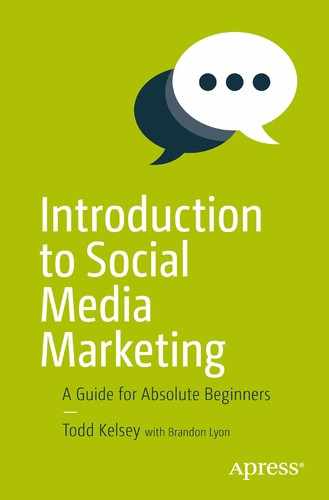This chapter is an introduction to Facebook ads, which are commonly used for social media marketing. There’s some discussion of the type of ads and the traditional value of using them, as well as some things that have changed in Facebook as new types of ads have been introduced. You also have an opportunity to create a Facebook ad. You will advertise a blog or site you created after reading Chapter 2 or use Facebook ads to advertise a Facebook page that you created in Chapter 3. My recommendation is to make or find a web site that you want to advertise a bit, create an ad, and try running it for a week or so. Toward the end of this chapter, we look at “monitoring” Facebook ads, in order to evaluate their performance.
What Are Facebook Ads and Why Should You Use Them?
The most common type of Facebook ad is the kind that appears on the right side of the page when you log in to Facebook. Here are some examples.

Another type of ad appears directly in your newsfeed, alongside posts from your friends and from Facebook pages that you have liked. At the very top, it says Suggested Post:

You don’t need to be a business selling a product or service to use Facebook ads—anyone can use them. For example, I made this little ad to see if I could lure some people into reading a science fiction short story:

It leads to a site called Wattpad . I wasn’t selling anything per se, I was just promoting some fiction that I had written:

When to Use Facebook Ads
The bottom line on Facebook ads is that in the foreseeable future, people are still spending a lot of time on Facebook. There’s evidence to suggest that younger people are spending more time on messaging apps like Snapchat, WhatsApp, and others, and spending less time on Facebook (since their parents are on it?), but at the end of the day, people are still spending a lot of time on Facebook.
So one principle about Facebook ads, and any kind of social media marketing, is that it “goes with the flow”. That is, wherever people are spending time.
Note
Another point to keep in mind about “trending” is that people are increasingly spending online time on mobile devices , and the way ads appear on mobile devices is different than “desktop” ads that appear when you’re on Facebook or other social networks based on using a desktop or laptop computer. In the case of Facebook ads, you’ll see that there’s an option for making them available to mobile users. If I’m not mistaken I think that roughly half the ads on Facebook at the time of this writing are displaying to mobile users.
In terms of when to use Facebook ads, there’s not really a right or wrong time, but the most common uses include when promoting Facebook pages, where the ad is on Facebook—it is displayed to Facebook users—and the goal is to get people to visit the Facebook page and click the Like button.
As discussed in previous chapters, one fundamental question to ask is whether you are getting a return on investment from something like a Facebook page. If you or your client has the goal of “increasing likes,” then a Facebook ad is a good way to get a social media presence established. At a very basic level, even if you’re not planning or necessarily assuming you’ll actually make money with social media marketing, you might end up seeing it as a credibility issue—“because everyone else is doing it”. It is arguable that people use company Facebook pages as a way to find or learn about a business.
What I’ve seen professionally is a trend toward using Facebook ads for “traditional” display advertising, meaning using an ad on Facebook to point to an external web site, with some kind of image and text. This is an example of overlapping with “traditional” Internet marketing and social media marketing. In traditional Internet marketing, a display ad might appear on a news web site, for example, and consist of some kind of image or animation and text, which points toward some kind of web site.
Social networks came along and social media marketing was born. The general goal and scope of social media marketing is to establish and maintain a presence on social media. But a Facebook ad can be used for “traditional” purposes as well—it might just be to advertise a web site.
This is a topic worth discussing or even debating and some argue that any presence on the Internet is necessarily social, and that social media marketing helps businesses understand that the new era of consumer interaction is more personal. It could be argued that a “traditional” web site is part of an overall social media presence.
Purchase Intent
I think another helpful principle when considering Facebook ads is the question of purchase intent. In general, placing an ad on a search engine is different than placing one on a “general” site. People are more likely to go on Google or other search engines when they are researching a product—basically when they have an intent to purchase. While it may change over time, it’s generally accepted that people are mostly going on Facebook to see what their friends are up to or to post material—not necessarily to make purchases . There are posts that amount to social referrals, such as, “hey, look what I’ve got” or “hey, I recommend this”. However, it’s still the case that the purchase intent is probably significantly lower than with search engines.
This intent translates to statistics—even though there is less of a chance of a purchase when on Facebook, advertisers still place ads there. The statistics may be lower on getting purchases, but it can still happen. Just something to keep in mind.
Metrics for Measuring Facebook Ads
While learning about Facebook ads, there are some concepts that are worth considering. Facebook and other ad platforms display a lot of information when you’re running an ad campaign. You don’t necessarily need to know all the particulars in order to make use of them. I recommend exploring and seeing this as an experiment. The more you use Facebook ads in business settings, the more you’ll be interested in some of the finer points over time.
At a high level, when you create an ad on Facebook, there will eventually be a variety of information that shows you how your ad performed:
A central concept, perhaps the central concept, is the question of how many clicks the ad got:

In the end, the purpose of the ad is to get people to click on it and to visit a particular page or site.
Another concept to consider is click-through rate. It’s also known as CTR .
For example, in the following figure , you can see in the Reach category, that in theory, the ad was displayed to 61,432 people. There were 81 clicks. So the click-through rate was .081%.

The click-through rate gives you a way to look at performance. You might start out with a particular click-through rate, or you might try having multiple versions of an ad, with different images and text, and see which gives you a better click-through rate.
Targeting an Ad
Another central concept in ads is targeting. When you create an ad on Facebook, you can pick specific audiences, and the more targeted your ad is, the better it will perform generally speaking. In other words, the more your ad is focused on appealing to a particular audience, the better it will do.
Part of the targeting process is the ad itself. In a really simple example earlier, I included some phrases about the story I wrote, which might be of interest to people who like science fiction:

In the Targeting section of Facebook , I chose people who expressed an interest in science fiction in their Facebook profiles. I also chose a particular geographic area and language:

Targeting is a way to match your advertisement to a particular audience.
Now for the fun stuff!
Creating a Campaign
To create a campaign, go to https://www.facebook.com/business/a/campaign-structure .

Click on Create an Ad.
From time to time, Facebook will change its interface. At the time of this writing, the wizard allows you to choose from various kinds of ads. I suggest trying the Page Likes or Clicks to Website options:

With the Clicks to Website ad, you provide the link to a web site you want to send people to (such as the blog you created in Chapter 2).

You simply enter the link and click Continue:
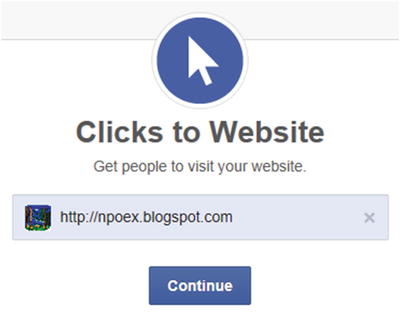
(Note: When you enter the link, it may flip you to another page even before you click Continue.)
On the next page, you’ll have the opportunity to do some targeting, by choosing what audience you want the ad to display to:


As you make choices on the left side, the Audience Definition on the right side will be updated in real-time:

This is an interesting area to experiment with. To start, try entering language options.


Then try entering Interests . This is where you can really focus on a particular audience.
If you’re keeping track of the numbers, you’ll see that at the time of this writing, you start out with around 184,000,000 people you can send an ad to if you don’t target them at all. These are the people who speak English in the United States who are also on Facebook.
As soon as you start entering interests, the numbers go down. People who have expressed a particular interest or liked a page that falls in a particular category, etc. There’s a smaller potential pool, but this is a good thing. The ad is more targeted, so people who see it are more likely to click on it, at least in theory.

For now, I suggest skipping over Behaviors and Connections, but you might click on the little “i” circular icons in these sections to get more information.

Next you get into the Account and Campaign section.
Budgeting for Facebook ads is an art and a science. There are no universal rules, but a basic principle is that the more competition there is for a particular audience, the more the ads will cost.
One method for paying for ads is based on quantity, that is, the number of ads that are displayed. The other method is where you pay only for clicks that actually take place.
This is an area that periodically goes through changes, but the basic idea is you figure out a schedule—how much you’re willing to pay—and then set it in motion .
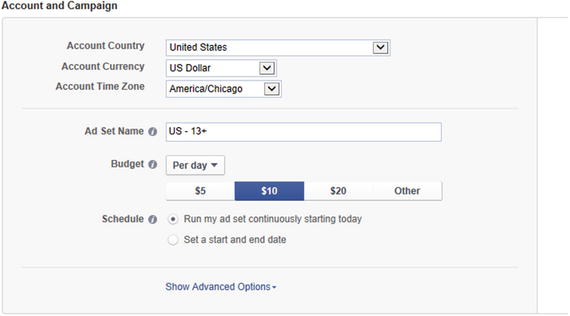
And Now for Something Really, Really, Really Important
I think the most important point to keep in mind, especially when you’re learning, is to know how to set a start and end date. That way, your credit card does not get continuously charged! Click on Set a Start and End Date to do this.

If you’re just learning, you might want to try a week-long campaign.

Instead of a suggested daily budget, you might click on the Per Day drop-down menu and choose a lifetime budget :


It will suggest a $50 budget, but you can click on Other:

You can type in something like $10-20:

Be sure to set an end date:

Click on Show Advanced Options to see what’s there:

Facebook will automatically bid on ads for you. That means that it will look at your ad, the audience, and choose the best bid to get you clicks—that is, amount that will be paid for each click. On Facebook and Google, in the end, the advertising price is an auction process. You indicate a willingness to pay a certain amount, and depending on competition, the price will go up or down. You can always limit the maximum you will pay for a single click.

For example, you can click the Manually Set Your Maximum Bid for Clicks (CPC) option:

There is a little suggested range and you can accept the specific suggestion or change it.

(You can also change this range after your campaign is running.)
Next, Facebook allows you to upload an image for the ad. In some cases, if you’re creating an ad for a Facebook page, it will look on the page and automatically suggest the logo. With an external web site, it can also suggest images. This is a section that highlights the need for content (see Chapter 2—nudge nudge) and working with digital images. You might want to use images from clipart.com or work with them in Photoshop or a free program like GIMP, and then add text to the image. But to experiment, you can just use a digital picture.
Tip
If you know of an image that you want to use on the web, you can also right-click on it (in Windows) or Ctrl+click (on a Mac) and download it to your computer. Remember to respect any copyrights!

Tip
If you’re looking for image, you might like to review a Google search such as:
Or explore a site such as http://www.openstockphotography.org/ .
Next, you can select the headline and text for an ad.
So in the Text and Links area, you can type in a headline and some text. Also, to keep things simple in this scenario, click Turn Off News Feed Ads. (An ad that appears in the newsfeed has to come from somewhere. That is, it will look as if someone posted it, so it can use the icon of your Facebook page.)

When you type a headline , it gives you a running count of how many letters you have left:

The idea is to keep things simple. Offer a value proposition and a call to action of some kind:

Just look at what you’re working on and consider what would get you to click on it.
On the right side of the screen, it’s giving you some information about where the ad is going to appear.
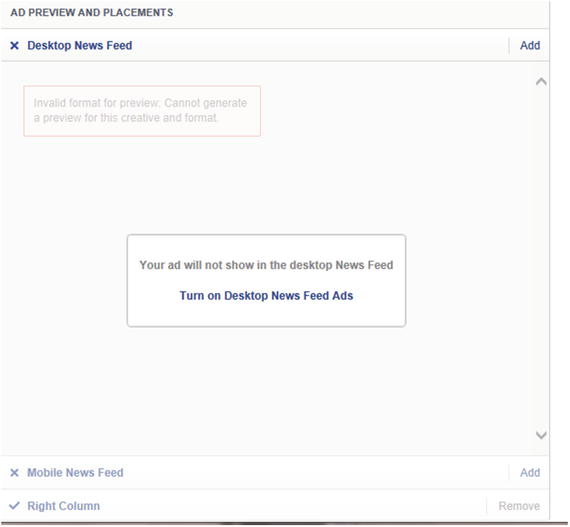
This is the area where you can activate an ad to appear on a mobile device by clicking the Add link:
Finally, click Place Order:
(Note: If it is the first time you are making an ad, you’ll need to enter billing information. Remember to make sure you’re aware of how long the ad will be running.)
Monitoring the Campaign
The ad has to be reviewed and approved. You can see how things are going by visiting https://www.facebook.com/ads/manage .
You then click on the campaign name to drill down to the ad level:

After an ad starts running, this dashboard will show reach, which is how many people may have looked at it, and then it will show any clicks that occurred. At this point you will be looking at an ad set, which is a group of ads in the same campaign. You can create multiple ads with various images/copy/targeting and see how they perform against each other. To drill down further, click on the Ad Set name:

Then, to get a closer look at the ad, click on the ad’s name:

Then you’ll see the information and images you originally put into the ad. This is also where you can edit things if you want to:
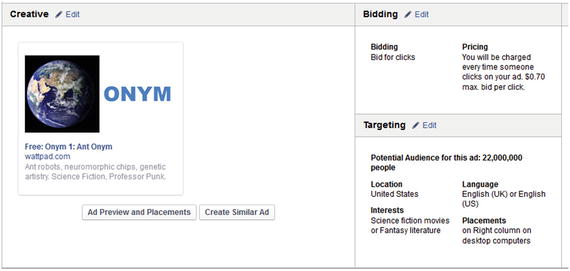
In this case, I wanted to generate some clicks. The performance I wanted to measure was how many clicks I got:

I also wanted to see how much money was spent.

In order to get about 80 people to come and see my short story, it cost me about 50 cents a click.
Learning More
There are a lot of resources out there for learning more about how ads work. Although I have a healthy skepticism for the ROI, it is definitely true that many businesses have benefitted financially from Facebook. As examples, see these success stories on Facebook:
When you’re wandering around an interface, try clicking on everything, especially the little question marks:

To learn about Reach, click on the question mark next to it, for example:

Additional areas for information include https://www.facebook.com/business/products/ads . The main help section also includes a program called “Start to Success” that you might be interested in. See https://www.facebook.com/help/458369380926902 .
Free Facebook Ads
You can also explore promotions that companies offer that give you free Facebook advertising credit. For example, try entering the following in Google:

Conclusion
Congratulations on making it through the chapter. The best advice I can give on learning about Facebook ads is to explore them, try them out, and spend some time in the help sections on Facebook. I also suggest keeping things simple. It can be a lot of fun to see the clicks start coming through the first time you try, which can naturally lead to learning more about the features and options that help make your ads perform better.
If you’re an intern or student, try to find a web site and set the goal of seeing how many clicks you can get. Then try again to see if you can come up with more compelling images, or text, or more focused targeting. See what your original click-through rate was and see if you can improve it.
You may want to start asking the question, “what’s my ROI?”. If you’re interested in selling something, you’ll want to start looking into a topic called conversion, which is tracing an ad down to the point of actually selling something.
